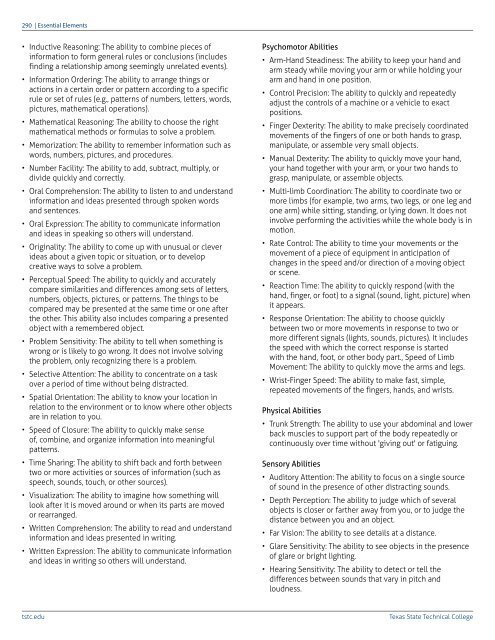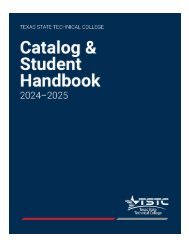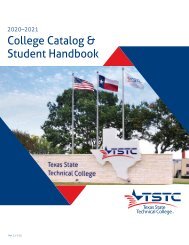Student Handbook and Catalog 2021-22 V2
Create successful ePaper yourself
Turn your PDF publications into a flip-book with our unique Google optimized e-Paper software.
290 | Essential Elements<br />
• Inductive Reasoning: The ability to combine pieces of<br />
information to form general rules or conclusions (includes<br />
finding a relationship among seemingly unrelated events).<br />
• Information Ordering: The ability to arrange things or<br />
actions in a certain order or pattern according to a specific<br />
rule or set of rules (e.g., patterns of numbers, letters, words,<br />
pictures, mathematical operations).<br />
• Mathematical Reasoning: The ability to choose the right<br />
mathematical methods or formulas to solve a problem.<br />
• Memorization: The ability to remember information such as<br />
words, numbers, pictures, <strong>and</strong> procedures.<br />
• Number Facility: The ability to add, subtract, multiply, or<br />
divide quickly <strong>and</strong> correctly.<br />
• Oral Comprehension: The ability to listen to <strong>and</strong> underst<strong>and</strong><br />
information <strong>and</strong> ideas presented through spoken words<br />
<strong>and</strong> sentences.<br />
• Oral Expression: The ability to communicate information<br />
<strong>and</strong> ideas in speaking so others will underst<strong>and</strong>.<br />
• Originality: The ability to come up with unusual or clever<br />
ideas about a given topic or situation, or to develop<br />
creative ways to solve a problem.<br />
• Perceptual Speed: The ability to quickly <strong>and</strong> accurately<br />
compare similarities <strong>and</strong> differences among sets of letters,<br />
numbers, objects, pictures, or patterns. The things to be<br />
compared may be presented at the same time or one after<br />
the other. This ability also includes comparing a presented<br />
object with a remembered object.<br />
• Problem Sensitivity: The ability to tell when something is<br />
wrong or is likely to go wrong. It does not involve solving<br />
the problem, only recognizing there is a problem.<br />
• Selective Attention: The ability to concentrate on a task<br />
over a period of time without being distracted.<br />
• Spatial Orientation: The ability to know your location in<br />
relation to the environment or to know where other objects<br />
are in relation to you.<br />
• Speed of Closure: The ability to quickly make sense<br />
of, combine, <strong>and</strong> organize information into meaningful<br />
patterns.<br />
• Time Sharing: The ability to shift back <strong>and</strong> forth between<br />
two or more activities or sources of information (such as<br />
speech, sounds, touch, or other sources).<br />
• Visualization: The ability to imagine how something will<br />
look after it is moved around or when its parts are moved<br />
or rearranged.<br />
• Written Comprehension: The ability to read <strong>and</strong> underst<strong>and</strong><br />
information <strong>and</strong> ideas presented in writing.<br />
• Written Expression: The ability to communicate information<br />
<strong>and</strong> ideas in writing so others will underst<strong>and</strong>.<br />
Psychomotor Abilities<br />
• Arm-H<strong>and</strong> Steadiness: The ability to keep your h<strong>and</strong> <strong>and</strong><br />
arm steady while moving your arm or while holding your<br />
arm <strong>and</strong> h<strong>and</strong> in one position.<br />
• Control Precision: The ability to quickly <strong>and</strong> repeatedly<br />
adjust the controls of a machine or a vehicle to exact<br />
positions.<br />
• Finger Dexterity: The ability to make precisely coordinated<br />
movements of the fingers of one or both h<strong>and</strong>s to grasp,<br />
manipulate, or assemble very small objects.<br />
• Manual Dexterity: The ability to quickly move your h<strong>and</strong>,<br />
your h<strong>and</strong> together with your arm, or your two h<strong>and</strong>s to<br />
grasp, manipulate, or assemble objects.<br />
• Multi-limb Coordination: The ability to coordinate two or<br />
more limbs (for example, two arms, two legs, or one leg <strong>and</strong><br />
one arm) while sitting, st<strong>and</strong>ing, or lying down. It does not<br />
involve performing the activities while the whole body is in<br />
motion.<br />
• Rate Control: The ability to time your movements or the<br />
movement of a piece of equipment in anticipation of<br />
changes in the speed <strong>and</strong>/or direction of a moving object<br />
or scene.<br />
• Reaction Time: The ability to quickly respond (with the<br />
h<strong>and</strong>, finger, or foot) to a signal (sound, light, picture) when<br />
it appears.<br />
• Response Orientation: The ability to choose quickly<br />
between two or more movements in response to two or<br />
more different signals (lights, sounds, pictures). It includes<br />
the speed with which the correct response is started<br />
with the h<strong>and</strong>, foot, or other body part., Speed of Limb<br />
Movement: The ability to quickly move the arms <strong>and</strong> legs.<br />
• Wrist-Finger Speed: The ability to make fast, simple,<br />
repeated movements of the fingers, h<strong>and</strong>s, <strong>and</strong> wrists.<br />
Physical Abilities<br />
• Trunk Strength: The ability to use your abdominal <strong>and</strong> lower<br />
back muscles to support part of the body repeatedly or<br />
continuously over time without 'giving out' or fatiguing.<br />
Sensory Abilities<br />
• Auditory Attention: The ability to focus on a single source<br />
of sound in the presence of other distracting sounds.<br />
• Depth Perception: The ability to judge which of several<br />
objects is closer or farther away from you, or to judge the<br />
distance between you <strong>and</strong> an object.<br />
• Far Vision: The ability to see details at a distance.<br />
• Glare Sensitivity: The ability to see objects in the presence<br />
of glare or bright lighting.<br />
• Hearing Sensitivity: The ability to detect or tell the<br />
differences between sounds that vary in pitch <strong>and</strong><br />
loudness.<br />
tstc.edu<br />
Texas State Technical College
















